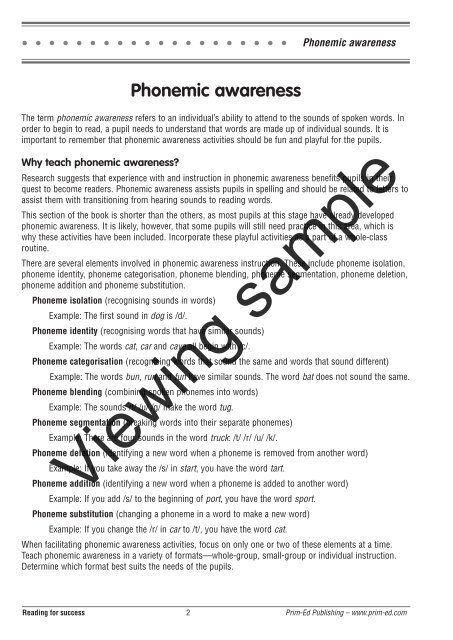PR-6219UK Reading for Success - Book 4
You also want an ePaper? Increase the reach of your titles
YUMPU automatically turns print PDFs into web optimized ePapers that Google loves.
Phonemic awareness<br />
Phonemic awareness<br />
The term phonemic awareness refers to an individual’s ability to attend to the sounds of spoken words. In<br />
order to begin to read, a pupil needs to understand that words are made up of individual sounds. It is<br />
important to remember that phonemic awareness activities should be fun and playful <strong>for</strong> the pupils.<br />
Why teach phonemic awareness?<br />
Research suggests that experience with and instruction in phonemic awareness benefits pupils in their<br />
quest to become readers. Phonemic awareness assists pupils in spelling and should be related to letters to<br />
assist them with transitioning from hearing sounds to reading words.<br />
This section of the book is shorter than the others, as most pupils at this stage have already developed<br />
phonemic awareness. It is likely, however, that some pupils will still need practice in this area, which is<br />
why these activities have been included. Incorporate these playful activities as a part of a whole-class<br />
routine.<br />
There are several elements involved in phonemic awareness instruction. These include phoneme isolation,<br />
phoneme identity, phoneme categorisation, phoneme blending, phoneme segmentation, phoneme deletion,<br />
phoneme addition and phoneme substitution.<br />
Phoneme isolation (recognising sounds in words)<br />
Example: The first sound in dog is /d/.<br />
Phoneme identity (recognising words that have similar sounds)<br />
Example: The words cat, car and cave all begin with /c/.<br />
Phoneme categorisation (recognising words that sound the same and words that sound different)<br />
Example: The words bun, run and fun have similar sounds. The word bat does not sound the same.<br />
Phoneme blending (combining spoken phonemes into words)<br />
Example: The sounds /t/ /u/ /g/ make the word tug.<br />
Phoneme segmentation (breaking words into their separate phonemes)<br />
Example: There are four sounds in the word truck: /t/ /r/ /u/ /k/.<br />
Phoneme deletion (identifying a new word when a phoneme is removed from another word)<br />
Viewing sample<br />
Example: If you take away the /s/ in start, you have the word tart.<br />
Phoneme addition (identifying a new word when a phoneme is added to another word)<br />
Example: If you add /s/ to the beginning of port, you have the word sport.<br />
Phoneme substitution (changing a phoneme in a word to make a new word)<br />
Example: If you change the /r/ in car to /t/, you have the word cat.<br />
When facilitating phonemic awareness activities, focus on only one or two of these elements at a time.<br />
Teach phonemic awareness in a variety of <strong>for</strong>mats—whole-group, small-group or individual instruction.<br />
Determine which <strong>for</strong>mat best suits the needs of the pupils.<br />
<strong>Reading</strong> <strong>for</strong> success 2 Prim-Ed Publishing – www.prim-ed.com


















